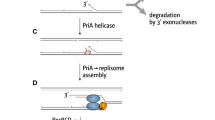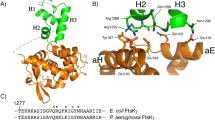Summary
Transfer of a UV-damaged F sex factor to a recipient λ lysogen induces prophage λ development. Under these conditions RecA protein synthesis was induced and λ repressor cleaved, as observed upon direct induction, that is, when the recipient λ lysogen was directly exposed to UV-light. The efficiency of induction of RecA protein synthesis in recipient bacteria which had received an irradiated F-lac factor was about 80% of that measured upon direct induction. We observed the simultaneous disappearance of λ repressor and a slight production of cleavage fragments; quantitation by densitometric scanning of the autoradiogram after correction for the efficiency of transfer indicated that 55% of λ repressor was cleaved. Transfer of UV-damaged Hfr DNA failed to induce RecA protein synthesis. A λ phage vector carrying oriF, the cloned origin of F plasmid replication, after exposure to UV-light and infection of a recipient lysogen, induced RecA protein synthesis and a moderate but significant cleavage of λ repressor. Indirect induction by UV-damaged F sex factor or phage λoriF resulted in biochemical cellular reactions similar to those observed upon direct induction. LexA repressor that negatively controls RecA protein synthesis appeared more susceptible to cleavage than did λ repressor.
Similar content being viewed by others
References
Achtman M (1975) Mating aggregates in Escherichia coli conjugation. J Bacteriol 123:505–515
Bailone A, Levine A, Devoret R (1979) Inactivation of prophage λ repressor in vivo. J Mol Biol 131:553–572
Baluch J, Sussman R (1978) Correlation between UV dose requirement for lambda bacteriophage induction and lambda repressor concentration. J Virol 26:595–602
Baluch J, Chase JW, Sussman R (1980) Synthesis of RecA protein and induction of bacteriophage lambda in single-strand deoxyribonucleic acid-binding protein mutants of Escherichia coli. J Bacteriol 144:489–498
Benbow RM, Devoret R, Howard-Flanders P (1973) Indirect ultraviolet induction and curing in E. coli cells lysogenic for bacteriophage λ. Mol Gen Genet 120:355–368
Bernstein C (1981) Deoxyribonucleic acid repair in bacteriophage. Microbiol Rev 45:72–98
Bockrath RC, Hanawalt PC (1980) Ultraviolet light induction of recA protein in a recB uvrB mutant of Escherichia coli. J Bacteriol 143:1025–1028
Borek E, Ryan A (1958) The transfer of irradiation-elicited induction in a lysogenic organism. Proc Natl Acad Sci USA 44:374–377
Brent R, Ptashne M (1981) Mechanism of action of the lexA gene product. Proc Natl Acad Sci USA 78:4204–4208
Couturier M, Janssens J, Bex J, Desmyter A, Bonnevalle I (1979) Construction in vitro of “phage-plasmid” chimerae: a new tool to analyse the mechanism of plasmid maintenance. Mol Gen Genet 169:113–116
Craig NL, Roberts JW (1980) E. coli RecA protein-directed cleavage of phage λ repressor requires polynucleotide. Nature 283:26–30
Craig NL, Roberts JW (1981) Function of nucleoside triphosphate and polynucleotide in E. coli recA protein-directed cleavage of phage lambda repressor. J Biol Chem 256:8039–8044
Devoret R (1981) Prophage λ induction and inducible error-prone repair in Escherichia coli. In: Cohn WE (ed) Progress Nucl Acid Res and Mol Biol, vol 26. Academic Press, New York, pp 252–263
Devoret R, George J (1967) Induction indirecte du prophage λ par le rayonnement ultraviolet. Mutat Res 4:713–734
Devoret R, Pierre M, Moreau PL (1982) Induction of prophage 80 in a recA mutant of Escherichia coli K12. Mol Gen Genet (submitted)
Fangman WL, Novick A (1968) Characterization of two bacterial mutants with temperature-sensitive synthesis of DNA. Genetics 60:1–17
George J, Devoret R (1971) Conjugal transfer of UV-damaged F-prime sex factors and indirect induction of prophage λ. Mol Gen Genet 111:103–119
George J, Devoret R, Radman M (1974) Indirect ultraviolet-reactivation of phage λ. Proc Natl Acad Sci USA 71:144–147
Gudas LJ, Mount DW (1977) Identification of the recA (tif) gene product of Escherichia coli. Proc Natl Acad Sci USA 74:5280–5284
Gudas LJ, Pardee AB (1976) DNA synthesis inhibition and the induction of protein X in Escherichia coli. J Mol Biol 101:459–477
Howard-Flanders P, Boyce RP (1966) DNA repair and genetic recombination: studies of mutants of Escherichia coli defective in these processes. Radiat Res Suppl 6:156–184
Howard-Flanders P, Rupp WD, Wilkins BM, Cole RS (1968) DNA replication and recombination after UV-irradiation. Cold Spring Harbor Symp Quant Biol 33:195–207
Kenyon CJ, Walker GC (1980) DNA-damaging agents stimulate gene expression at specific loci in Escherichia coli. Proc Natl Acad Sci USA 77:2819–2823
Laemmli UK, Favre M (1973) Maturation of the head of bacteriophage T4. J Mol Biol 80:575–599
Laurell CB (1966) Quantitative estimation of proteins by electrophoresis in agarose containing antibodies. Anal Biochem 15:45–52
Levine A, Bailone A, Devoret R (1979) Cellular levels of the prophage λ and 434 repressors. J Mol Biol 131:655–661
Little JW, Edmiston SH, Pacelli LZ, Mount DW (1980) Cleavage of Escherichia coli lexA protein by the RecA protease. Proc Natl Acad Sci USA 77:3225–3228
Little JW, Mount DW, Yanisch-Perron CR (1981) Purified lexA protein is a repressor of the recA and lexA. Proc Natl Acad Sci USA 78:4199–4203
Low B (1968) Formation of microdiploids in mating with a class of Rec− recipients strains of Escherichia coli K12. Proc Natl Acad Sci USA 60:160–167
McEntee K (1977) Protein X is the product of the recA gene of Escherichia coli. Proc Natl Acad Sci USA 74:5275–5279
McEntee K, Hesse JE, Epstein W (1976) Identification and radiochemical purification of the recA protein of Escherichia coli K-12. Proc Natl Acad Sci USA 73:3979–3983
Miller JH (1972) Experiments in molecular genetics. Cold Spring Harbor Laboratory, Cold Spring Harbor, New York
Monk M (1969) Induction of phage λ by transferred irradiated ColI DNA. Mol Gen Genet 106:14–24
Moreau P, Bailone A, Devoret R (1976) Prophage λ induction in Escherichia coli K12 envA uvrB: A highly sensitive test for potential carcinogens. Proc Natl Acad Sci USA 73:3700–3704
Moreau P, Devoret R (1977) Potential carcinogens tested by induction and mutagenesis of prophage λ in Escherichia coli K12. In: Origins of human cancer. Cold Spring Harbor Laboratory, New York, pp 1451–1472
Moreau PL, Fanica M, Devoret R (1980a) Induction of prophage λ does not require full induction of RecA protein synthesis. Biochimie 62:687–694
Moreau PL, Fanica M, Devoret R (1980b) Cleavage of λ repressor and induction of RecA protein synthesis elicited by aflatoxin B1 metabolites in Escherichia coli. Carcinogenesis 1:837–848
Mount DW (1979) Isolation and characterization of mutants of λrecA which synthesize a hyperactive recA protein. Virology 98:484–488
Paul AV, Riley M (1974) Joint molecule formation following conjugation in wild-type and mutant Escherichia coli recipients. J Mol Biol 82:35–56
Phyzicky E, Roberts JW (1980) Kinetics of RecA protein-directed inactivation of repressors of phage P22. J Mol Biol 139:319–328
Phyzicky E, Roberts JW (1981) Induction of SOS functions: regulation of proteolytic activity of E. coli recA protein by interaction with DNA and nucleoside triphosphate. Cell 25:259–267
Quillardet P, Moreau PL, Ginsburg H, Mount DW, Devoret R (1982) UV-reactivation and induction of phage λ in Escherichia coli K12 overproducing RecA protein. Mol Gen Genet (submitted)
Roberts JW, Roberts CW (1975) Proteolytic cleavage of bacteriophage lambda repressor in induction. Proc Natl Acad Sci USA 72:147–151
Roberts JW, Roberts CW (1981) Two mutations that alter the regulatory activity of E. coli recA protein. Nature 290:422–424
Roberts JW, Roberts CW, Craig NL (1978) Escherichia coli recA gene product inactivates phage λ repressor. Proc Nat Acad Sci USA 75:4714–4718
Rosner JL, Kass LR, Yarmolinsky MB (1968) Parallel behavior of F and P1 in causing indirect induction of lysogenic bacteria. Cold Spring Harbor Symp Quant Biol 33:785–789
Rupp WD, Howard-Flanders P (1968) Discontinuities in the DNA synthesized in an excision-defective strain of Escherichia coli following ultraviolet irradiation. J Mol Biol 31:291–304
Sancar A, Hack AM, Rupp WD (1979) Simple method for identification of plasmid-coded proteins. J Bacteriol 137:692–693
Satta G, Gudas LJ, Pardee AB (1979) Degradation of Escherichia coli DNA: evidence for limitation in vivo by protein X, the recA gene product. Mol Gen Genet 168:69–80
Shinagawa H, Mizuuchi K, Emmerson PT (1977) Induction of prophage lambda by γ-rays, mitomycin C and tif; repressor cleavage studied by immunoprecipitation. Mol Gen Genet 155:87–91
Steinborn G (1979) Uvm mutants of Escherichia coli K12 deficient in UV mutagenesis. II. Further evidence for a novel function in error-prone repair. Mol Gen Genet 175:203–208
Sussman R, Ben Zeev H (1975) Proposed mechanism of bacteriophage lambda induction: acquisition of binding sites for lambda repressor by DNA of the host. Proc Nat Acad Sci USA 72:1973–1976
Sussman R, Resnick J, Calame K, Baluch J (1978) Interaction of bacteriophage λ repressor with nonoperator DNA containing single-strand gaps. Proc Natl Acad Sci USA 75:5817–5821
Theile M, Scherneck S, Geissler E (1981) Influence of superinfection on the photoreversible phase of UV induced lysogenic bacteria. Mol Gen Genet 181:273–278
Weinstock GM, McEntee K (1981) RecA protein-dependent proteolysis of bacteriophage λ repressor. Caracterisation of the reaction and stimulation by DNA-binding protein. J Biol Chem 256:10883–10888
West SC, Cassuto E, Mursalim J, Howard-Flanders P (1980) Recognition of duplex DNA containing single-stranded regions by recA protein. Proc Natl Acad Sci USA 77:2569–2573
Willetts N, Skurray R (1980) The conjugation system of F-like plasmids. Annu Rev Genet 14:41–76
Witkin EM (1976) Ultraviolet mutagenesis and inducible DNA repair in Escherichia coli. Bacteriol Rev 40:869–907
Author information
Authors and Affiliations
Additional information
Communicated by G. O'Donovan
Rights and permissions
About this article
Cite this article
Moreau, P.L., Pelico, J.V. & Devoret, R. Cleavage of λ repressor and synthesis of RecA protein induced by transferred UV-damaged F sex factor. Mol Gen Genet 186, 170–179 (1982). https://doi.org/10.1007/BF00331847
Received:
Issue Date:
DOI: https://doi.org/10.1007/BF00331847




